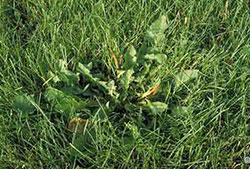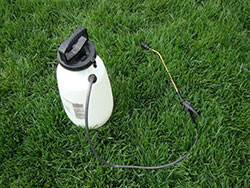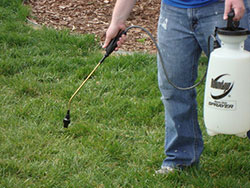Broadleaf weeds such as dandelions, clover and spurge can make a lawn look unkempt. The weeds also consume water and fertilizer intended for the lawn.
How can I control weeds?
 The first step in controlling weeds in lawns is to grow healthy, dense grass. Proper watering, mowing and fertilizing produces a thick lawn and discourages weeds. Hand weeding is effective with small weed populations. Although chemical weed killers are available, they shouldn’t be considered a substitute for proper lawn management.
The first step in controlling weeds in lawns is to grow healthy, dense grass. Proper watering, mowing and fertilizing produces a thick lawn and discourages weeds. Hand weeding is effective with small weed populations. Although chemical weed killers are available, they shouldn’t be considered a substitute for proper lawn management.
Are weed killers ok to come in contact with?
When mixing and applying broadleaf lawn weed killers, wear a long-sleeved shirt, long pants, shoes, goggles and chemical-resistant gloves. Wash non-disposable gloves with soap and water before removing. After application, thoroughly wash hands, face and other exposed skin with soap and water. A shower minimizes health risks from pesticides. Change clothing and launder clothes separately from other clothes before reuse. And don’t re-enter or permit others, including children and pets, to enter the treated area until the material has thoroughly dried.
How should I apply chemical weed killers?

Treat only individual plants or weed-infested spots with chemicals. General broadcast application over the entire lawn is not desirable. Liquid spot treatments generally are more effective than “weed-and-feed” type applications. When applying chemicals with a sprayer, spray weedy plants just until the foliage is moist. Apply dry granular formulations to wet grass and weeds.
When is the best time to apply weed killers?
Use herbicides when temperatures are between 65 and 85 degrees Fahrenheit. Do not apply it when temperatures are expected to rise above 85 degrees Fahrenheit within 24 hours of application. To minimize the danger of herbicide drift, spray weeds during a calm part of the day when there’s little or no wind. Don’t apply when rain is expected within 24 hours of application, and avoid watering for 24 hours after application.

A one- to five-gallon sprayer is often used to apply herbicides. Once a sprayer is used for herbicides, it should only be used for that purpose -not for applying liquid fertilizers, insecticides or fungicides. Easy-to-use, inexpensive garden hose sprayer attachments also are available. Application is accomplished by putting the herbicide into the attachment where it’s mixed with water as it comes from the hose. Uniform application and spray control are more difficult with this type of sprayer.
Can I use one weed killer for all weeds?
Because no single chemical kills all weeds, it’s necessary to know what weeds are in a lawn. The most common herbicide for controlling broadleaf weeds is 2,4-D, which may be used alone or in combination with related chemicals. Follow herbicide label directions carefully, and don’t exceed label application rates.
Are weed killers safe around other plants?
Grapes, tomatoes, new transplants and leafing trees are hypersensitive to chemical fumes and drift. Trees and shrubs are rather sensitive to products containing dicamba, also known as Banvel, so avoid or limit its use under woody plants.
For more information, see the following Colorado State University Extension fact sheet(s).
For more information, see the following Planttalk Colorado™ script(s).



